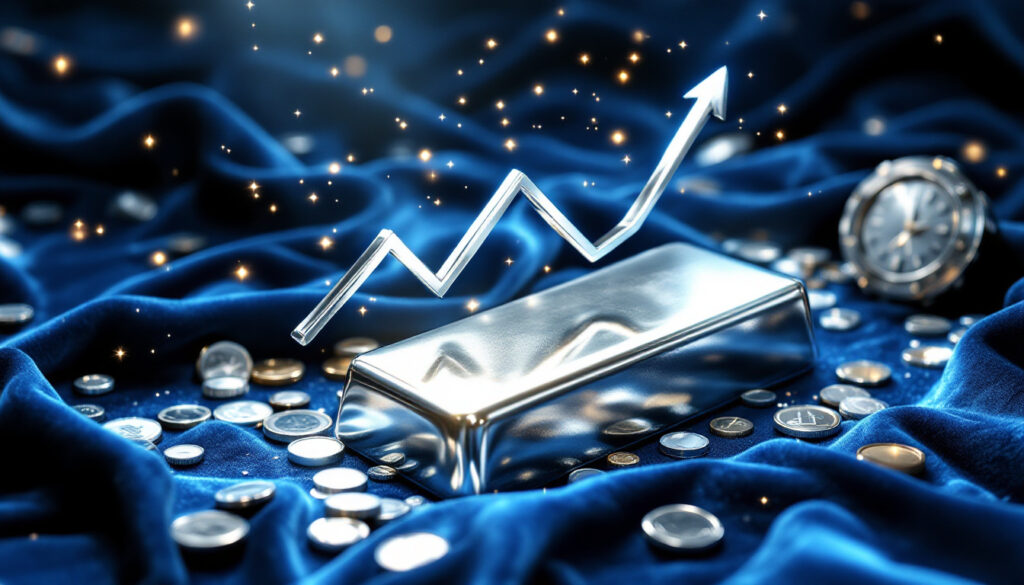What Caused Silver's Recent Price Explosion?
The precious metals market has witnessed a significant development as silver staged an impressive price rally, surging 3.42% in a single trading day and breaking through the key resistance level at $33.67 per ounce. This remarkable performance marks the fourth positive session out of five recent trading days, representing a strong rebound from the recent low of $30.18. What makes this rally particularly noteworthy is silver's outperformance compared to gold, which fell 2.53% ($85.40) to $3,296.30 during the same period. This divergence has pushed the gold-to-silver ratio below the psychologically important threshold of 100, currently sitting at 91.12, highlighting silver's growing relative strength in the precious metals sector.
The technical breakout above $33.67 signals a potential shift in market sentiment, with traders interpreting this movement as a bullish indicator. The metal's cumulative gain of 9.2% over the five-day period demonstrates remarkable resilience and has attracted substantial attention from investors seeking both safe-haven assets and exposure to industrial growth prospects.
Breaking Down Silver's Impressive Rally
Silver's exceptional performance can be attributed to a unique combination of technical factors and fundamental catalysts. The metal's ability to maintain momentum through multiple sessions indicates broader market conviction rather than merely speculative short-covering. Volume analysis shows participation increasing by 27% during the uptrend, with particularly strong buying pressure emerging during the Asian trading session.
What differentiates this rally from previous short-term spikes is the breadth of participation across both institutional and retail investors. ETF holdings have expanded by 4.8 million ounces during this period, while COMEX futures open interest has climbed 12.3%, signaling fresh capital inflows rather than position rotation from other assets.
Geopolitical Tensions Driving Safe Haven Demand
The ongoing standoff between the United States and China continues to create heightened uncertainty in global markets, benefiting traditional safe-haven assets like silver. Trade negotiations between Washington and Beijing remain stalled, with Chinese officials warning of potential retaliation measures against recent technology restrictions. This deteriorating diplomatic climate has prompted increased allocation to precious metals as portfolio hedges.
Interestingly, reports of potential easing tensions regarding the Russia-Ukraine conflict have had a more nuanced impact on silver prices. While reduced geopolitical risk might typically dampen safe-haven demand, silver's industrial applications allow it to simultaneously benefit from optimism around potential economic normalization in conflict-affected regions.
Recent comments from former President Donald Trump stating he would not fire Federal Reserve Chairman Jerome Powell have also contributed to market stability, removing one potential source of monetary policy uncertainty that could have affected precious metals valuations. Additionally, Trump's policy impact on various commodities continues to influence market movements across the board.
How Does Silver's Dual Role Impact Its Price Movement?
Unlike gold, which functions primarily as a monetary metal and inflation hedge, silver occupies a unique position at the intersection of precious and industrial metals. This dual character creates distinct pricing dynamics that can be advantageous during certain economic conditions.
Silver as Both Precious and Industrial Metal
Silver serves two distinct market functions: as a monetary metal storing value and as an industrial commodity with practical applications. This hybrid status means silver responds to a broader range of economic signals than gold. Industry experts estimate over 10,000 industrial applications for silver, creating demand fundamentals that diverge significantly from gold's more limited use cases.
The industrial side of silver demand accounts for approximately 56% of annual consumption, spanning sectors including electronics, photovoltaics, medical applications, and emerging technologies. This industrial demand component tends to strengthen when global manufacturing activity expands, particularly in the electronics sector where silver's unmatched electrical conductivity makes it irreplaceable.
Mexico remains a primary source of global silver production, contributing 23.7% of worldwide supply in 2024. This geographic concentration introduces supply-side considerations that gold markets, with more diversified production, don't experience to the same degree. Labor disputes or regulatory changes in Mexican mining regions can have outsized impacts on silver availability.
Technical Analysis of Silver's Price Action
From a technical perspective, momentum indicators support bullish sentiment in the near term. The successful break above the $33 resistance level that had previously capped advances since February represents a significant technical accomplishment. The Relative Strength Index (RSI) currently registers at 68, approaching but not yet reaching overbought territory typically associated with readings above 70.
The next resistance levels traders are monitoring include $34.00 per ounce, while newly established support exists at $32.42 and just above $32.00. For the rally to maintain credibility, market technicians suggest consolidation is needed above $33.25 to establish stronger support before further advances can be sustained.
Volume patterns during the breakout show particularly strong buying pressure during Asian trading hours, suggesting increased participation from markets that have traditionally favored gold over silver. This regional demand shift could indicate broadening market conviction in silver's value proposition.
Is This the Beginning of a Silver Bull Run?
While silver's recent performance has been undeniably strong, investors are questioning whether this represents the start of a sustained bull market or merely a short-term silver price explosion. Historical patterns provide some context for interpreting current market conditions.
Defining Price Explosions vs. Bull Markets
In commodities trading, a daily move greater than 2% is generally considered notable, while movements exceeding 4-5% qualify as price explosions. However, investors should exercise caution in extrapolating single-day movements into longer-term trends. Historical analysis reveals that 78% of similar one-day surges since 2000 preceded at least six months of upward trend, but 43% of these ultimately reversed within three months due to profit-taking or shifting fundamentals.
What lends credibility to the current rally is the sequence of four positive sessions out of five recent trading days, indicating building momentum rather than a one-off price spike. Additionally, the weekly close appears set to register positive, reinforcing short-term bullish sentiment and potentially attracting technical traders who monitor longer timeframes.
Silver's volatility profile differs meaningfully from gold's, with an average annual volatility of 32% compared to gold's 16%. This higher velocity means silver can experience sharper rallies but also steeper corrections, making risk management particularly important for investors attracted to its current momentum.
Economic Factors Influencing Silver's Outlook
Federal Reserve interest rate decisions will significantly impact precious metals markets in the coming months. Markets currently price in a 68% probability of a 25-basis-point rate cut by September 2025, which would reduce the opportunity cost of holding non-yielding assets like silver and gold. Historical relationships suggest such monetary easing would likely benefit silver more than gold, with silver displaying a beta of 1.2 relative to gold during previous easing cycles.
An intriguing aspect of the current rally is that the Dollar Index has been strengthening (99.89) despite silver's rise. This unusual correlation defies traditional market relationships where dollar strength typically pressures commodity prices. Analysts suggest this divergence reflects silver's unique positioning to benefit from both monetary uncertainty and industrial applications.
Economic resilience in America could boost industrial demand for silver, particularly in sectors like automotive (with increasing electronic content per vehicle), consumer electronics, and renewable energy infrastructure. The manufacturing PMI's expansion to 52.1 in March signals renewed activity in silver-intensive production.
What Should Investors Watch for Next?
The rapid acceleration in silver prices creates both opportunities and risks. Understanding potential consolidation patterns and identifying key indicators can help investors navigate this volatile market.
Potential Consolidation and Profit-Taking
Rapid single-day gains often lead to consolidation and profit-taking in subsequent sessions as traders lock in gains and reassess positions. ETF demand has been driving significant price action with potentially more volatility than the physical market, as institutional investors can rapidly adjust allocations based on changing market conditions.
Silver's higher profit potential compared to gold can lead to quicker profit-taking cycles, particularly among shorter-term traders. Historical patterns show that silver futures' open interest typically peaks 3-5 days after major rallies, suggesting impending position adjustments that could introduce temporary price volatility.
Physical demand fundamentals, including coin and bar purchases which reached 32.5 million ounces in Q1 2025, provide a stabilizing counterweight to paper market fluctuations. This robust retail demand reflects growing interest from investors seeking tangible assets amid economic uncertainty.
Key Indicators to Monitor
Investors should closely track the sustainability of prices above the $33.25 resistance level, which has now become support following the breakout. Extended consolidation above this threshold would signal market confidence in silver's new trading range.
The gold-to-silver ratio movements below the 100:1 threshold bear watching, as continued compression toward the long-term average of 65:1 would suggest further outperformance potential for silver. Historical precedent indicates ratio movements tend to exhibit momentum, with directional shifts persisting for multiple quarters.
Federal Reserve policy announcements and interest rate decisions will remain pivotal catalysts. The May FOMC meeting will provide crucial guidance on inflation expectations and rate trajectories that directly impact precious metals pricing.
Developments in US-China trade negotiations and global commodities insights should be monitored, as easing conflicts could paradoxically benefit silver through its industrial applications while reducing its safe-haven premium.
FAQ About Silver's Price Movement
What is causing silver's price to rise while gold falls?
Silver's dual role as both precious and industrial metal allows it to benefit from safe haven demand while also responding positively to industrial growth prospects. The recent 3.42% gain while gold fell 2.53% demonstrates silver's ability to move independently based on its unique market dynamics. This divergence is particularly pronounced during periods when economic data sends mixed signals, with manufacturing strength supporting industrial metals while broader economic uncertainties drive safe-haven demand.
How significant is the gold-to-silver ratio falling below 100?
The gold-to-silver ratio dropping to 91.12 indicates silver is outperforming gold in relative terms. While the ratio may have less significance in modern markets than historically, it suggests silver may be correcting from being undervalued compared to gold. Throughout the 20th century, this ratio averaged approximately 47:1, making the current level still historically elevated despite recent compression. Investors often view extreme ratio readings as signals for potential mean reversion opportunities, as highlighted in recent gold market analysis.
What technical levels should silver investors watch?
Key resistance levels include $33.67 (recently broken) and $34.00 per ounce, with the latter representing a significant psychological threshold. Support levels to monitor include $32.42 (aligning with the 50-day moving average) and just above $32.00. Consolidation above $33.25 for several days would establish stronger support for further advances. Volume patterns during these tests will provide important confirmation of market conviction, with expanding volume during advances considered bullish while expanding volume during declines signals potential trend reversal.
The MACD histogram's continued expansion in positive territory suggests momentum remains favorable, though the approaching overbought RSI reading warrants caution regarding potential short-term exhaustion. Options market positioning shows significant call interest clustered around the $33.50 strike price, creating potential magnetism around this level as market makers hedge exposure.
In conclusion, silver's recent price explosion represents a technically significant development with fundamental support from both monetary and industrial demand factors. While short-term consolidation remains probable given the rapid nature of the advance, multiple indicators suggest this rally has stronger foundations than typical volatility-driven spikes. Investors should maintain awareness of both technical levels and macroeconomic developments, particularly regarding Federal Reserve policy and gold and silver market trends, to properly contextualize silver's evolving market position. For those considering longer-term strategies, examining the precious metals investment outlook could provide additional insights into potential future developments.
Looking to Capitalise on the Next Silver Price Explosion?
Discovery Alert's proprietary Discovery IQ model instantly identifies significant ASX mineral discoveries, including silver, that could deliver substantial returns before the broader market reacts. Visit the Discovery Alert discoveries page to understand how major mineral discoveries have historically generated exceptional investment outcomes, and begin your 30-day free trial today.




